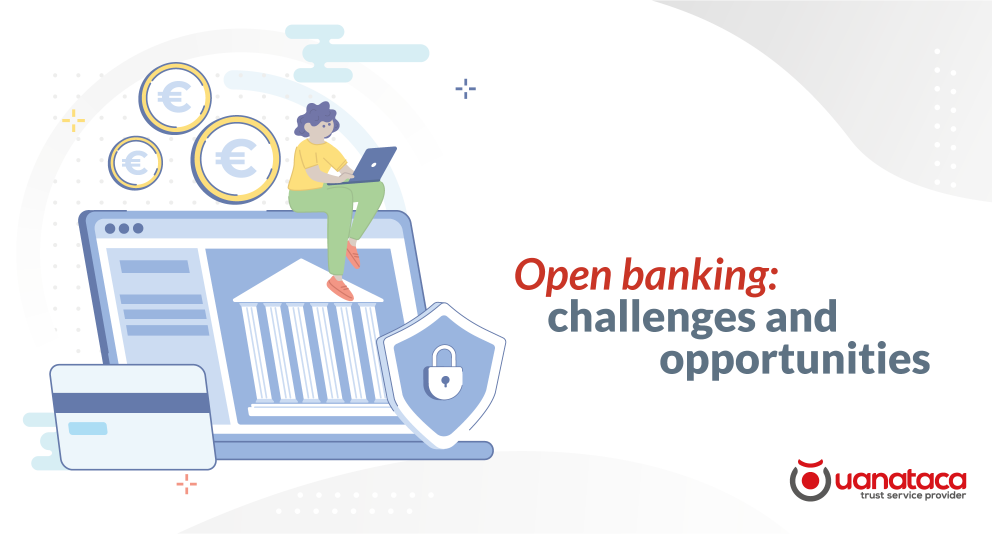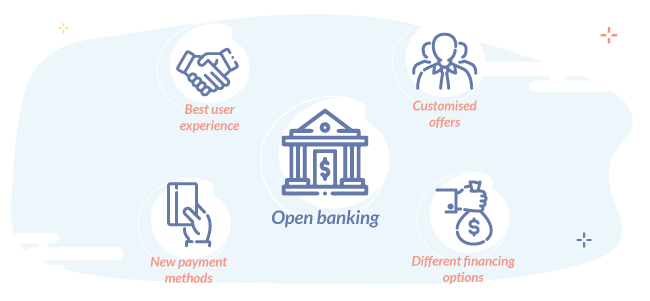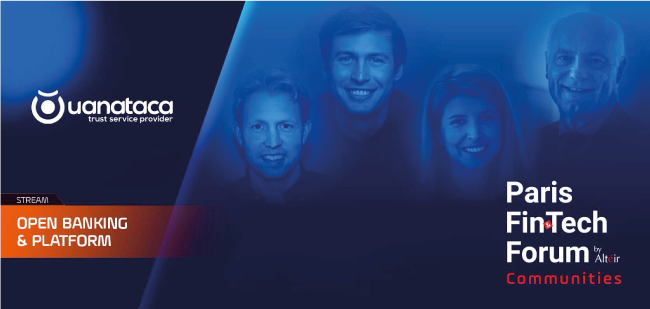
Technology and innovation have become the essential pillars of the financial sector's new business model, and customers are at the center of its structure. Giving them back control of their data and the power to decide on its management is the purpose of open banking.
The challenges and opportunities of open banking, considered by many as an important milestone in the financial industry, will be the central themes of the first inaugural session of the Paris Fintech Forum, the most exclusive European event in Finance and Fintech in which Uanataca participates as an official exhibitor.
In this article, we analyze the keys to the successful adoption of open banking and how electronic signature solutions are key in the focus on customer satisfaction.
What is open banking and why is it so important?
Open banking is a disruptive banking model comparable to the birth of telephone banking or online banking. Currently, at the heart of all industry transformations, open banking represents the definitive entry of the banking sector into the digital era and the positioning of the customer at the center of its services.
What is open banking? It is the practice of sharing financial information with third parties digitally, securely, and under conditions approved by customers through open APIs. Its legal framework is regulated by the European directive on digital payment services PSD2.
The opening of access to financial information, not without controversy and disagreement on the part of the more traditional banking sector with the fact of having to share banking data with other industries, restricting banking access to the data of these industries, will undoubtedly streamline the management of electronic commerce, benefiting both SMEs and individuals.

There are three main reasons why open banking is the driving force behind the radical overhaul of the financial industry. Firstly, the concession to customers of a more digital model aligned with their needs, with new services and greater power to act on their own data.
Secondly, the demand for Fintech is another reason why open banking is becoming firmly established in the financial ecosystem. Several arguments support their request, mainly access to data and protocols of other companies is almost vital to be able to provide their services and, on the other hand, the achievement of a favorable framework to develop their role as major players in technological cooperation and open innovation.
The regulatory framework is the third reason that has led to the arrival of open banking. Achieving a regulated and secure scenario favors the exchange of information and, consequently, users will be able to make the most of the internal market, finding better options adapted to their real needs.
Challenges and opportunities of open banking in the financial industry
There is no doubt that open banking is a great opportunity but like with any change, it comes with great challenges, risks, and many efforts that must be addressed rather than repelled. In this sense, the more traditional banking sector sees open banking as an opportunity as well as a threat, understanding the new model as an open door to new competitors.
At the same time, the disintermediation of the new open banking model and the entry of new players create a new challenge in terms of the number of providers, their security, and solvency. In response to this, customers may be reluctant to share certain highly sensitive banking information, such as their expenses or transactions. Faced with this situation and even though the final decision to share data rests with the customer, the technology faces the great challenge of gaining the customer's trust through data security and protection.
Breaking down regulatory barriers to the development of open banking, especially those related to the harmonization of regulations between different countries and sectors, is another of the great challenges that the industry must face standardizing fundamental aspects such as data format, security rules, and user experience. Most of the major traditional banks agree that open banking is a project in which regulations and standards are gradually taking shape.
However, despite the risks associated with any innovation, the forecasts for the banking sector are quite favorable. According to an Accenture report, banks that adopt the open banking model will benefit from a potential increase in revenue of 20%, while those that do not are in danger of losing 30%.
📢 The main challenges and opportunities of the new open banking business model will be the main focus of the opening session of the sixth edition of the Paris Fintech Forum, where Uanataca will be present as an official exhibitor.

In this first session, renowned international speakers from the financial sector will participate, including Jose Manuel Campa, Chairman at European Banking Authority, Iana Dimitrova, Chief Executive at OpenPayd or Zach Perret, CEO at Plaid.
Main strategies in the adoption of open banking
Banks that fail to implement open banking risk missing out on the advantages of platform-based business models. Faced with this challenge, it could be easy to get lost among the multiple adoption models if you do not have a solid and targeted strategy to offer differentiated services to your customers.
Below, we will discuss the main strategies to make open banking adoption fully successful, taking into account customer demands, partnerships, and agility of integration.
- Design engaging experiences and more personalized advice. Customer centricity should be the strategic core, with a long-term focus on customer loyalty.
- Strong partnerships as a key factor to speed up integration. Developing new solutions is a major investment, a process that can even extend the integration time by years. Alliances with technology and Fintech companies make it possible to reduce costs, optimize processes and be more agile in a market as competitive as the financial one.
- Develop new business processes that allow the associated ecosystems to be managed efficiently.
- New business models. Until now, the traditional business model was focused on developing and maintaining the core banking business. The advantages provided by Fintech together with APIs facilitate the integration of open banking and the possibility of creating a new business vertical, an independent line that can become as relevant as core banking.
What does a qualified electronic signature bring to the financial sector?
The future of banking depends on its digitization and the ability to adapt with agility to the demands of a new customer looking for complete digital experiences. In addition to the attractiveness of the personalized offer offered by open banking, other values influence the customer's decision, such as an offer of agile, secure, and mobile digital services.
In most of these financial services, it is common to contract different financial goods, such as the issuance of a loan or a consumer credit, which need to be signed. The digitization of the signing process allows operations to be carried out in real-time, autonomously, and securely, meeting the customer's expectations on a mobile and digital offer.
As mentioned above, in the new business model of the financial industry, customer confidence in the company and its technology is fundamental. To achieve this, the electronic signature solution must be the right one.
Of the three types of electronic signature contemplated in the European Union Regulation No. 910/2014 (eIDAS), only the qualified electronic signature offers the maximum legal guarantees and contrary to what may be thought, its use is extremely simple. Its legal effects are equivalent to the handwritten signature,

In order to meet the needs of the financial industry and the regulatory compliance to which it is subject, Uanataca provides services that guarantee that its qualified signature solutions are issued in accordance with the European eIDAS Regulation, meeting all the necessary requirements to ensure their legality.
Main advantages of Uanataca's solutions for the financial industry.
At the forefront of technology, Uanataca has created the first system that allows the financial industry to interact with its customers remotely using a qualified electronic signature, with reversal of the burden of proof, 100% digital and from any device connected to the internet.These are only a few of the main advantages of its solutions:
- Full integration with business applications, without transitions that negatively affect the user experience.
- Self-contained evidence in the signed documents, avoiding the generation of a new document each time it is signed and the custody of this one.
One-Shot Signature and Bulk Signature: Uanataca’s solutions for Fintech
One-Shot Signature and Automated Signature are two of Uanataca's solutions for Fintech, developed to successfully undertake the digitization of signature processes and lay the foundations for new and innovative projects.
📢 Do you want to discover the advantages of One-Shot Signature or Bulk Signature for Fintech? Request a free personalized demo.
